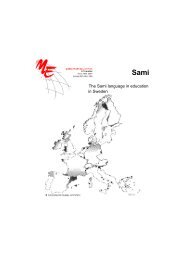Multilingual Early Language Transmission (MELT) - Mercator ...
Multilingual Early Language Transmission (MELT) - Mercator ...
Multilingual Early Language Transmission (MELT) - Mercator ...
Create successful ePaper yourself
Turn your PDF publications into a flip-book with our unique Google optimized e-Paper software.
Spanish-English) child. She followed a toddler (age 1;10) and showed that early trilingual<br />
phonological differentiation is possible. Simultaneous multilingual exposure does not appear<br />
to delay children in their initial language discrimination or production capacities. Bosch &<br />
Sebastián-Gallés (2001) reported some research results of assumptions who were made to<br />
believe that simultaneous acquisition, of two or three languages, would slow down normal<br />
language development and simultaneous exposure to more than one language might even<br />
lead to an ‘enhanced language discrimination capacity.’<br />
Montanari (2011) stresses the fact that much more research is needed; studies need to be<br />
conducted with children learning pairs and triplets of typologically related and unrelated<br />
languages; more work needs to assess whether all children, irrespective of learning style and<br />
type of environment in which they are raised, show signs of differentiation in the course of<br />
development and more research to investigate whether the development of each language<br />
in multilingual children is autonomous or interdependent.<br />
4.2 <strong>Early</strong> immersion approach in pre-school education<br />
It is difficult to clearly define early immersion, because of the different situations, the<br />
complex pre-school settings and its contexts. Below some definitions of the concept<br />
‘immersion’ are presented.<br />
Obadia (in Arnau & Artigal, 1998) gives a definition of immersion program: “An immersion<br />
program (also known as a multilingual, intensive or extended program) is defined as a<br />
program in which one or more subjects are taught in a language different from the language<br />
of the home at either the elementary, secondary or post-secondary level.”<br />
Wode also (in Arnau & Artigal, 1998) defines immersion: “According to Genesee (1987) the<br />
Canadian usage of the term immersion is such that it is applied only to those programs that<br />
are designed for majority-language children and that devote medium of instruction;<br />
programs with less than 50% are labelled extended core. The reason for this distinction is<br />
that government funds will only give to programs that do, in fact, carry at least 50 % of the<br />
curriculum in the foreign language.”<br />
Immersion is a method of teaching a second language. The target language is used for<br />
instruction. Cummins (2000) describes two-way immersion with two major models of twoway<br />
programs: 90/10 and 50/50 programs. These models represent the proportion of time<br />
devoted to the minority and majority languages in the early grades of the program. The<br />
90/10 model aims to promote the minority language as much as possible in the early grades<br />
on the assumption that the minority language has a lower status in the wider community.<br />
The 50/50 model is based on the belief that both languages need to be acquired from the<br />
beginning of schooling and the best way to do this is to split the instruction time between<br />
the two. Cummins (2000) agrees that both programs can work well.<br />
Double immersion has also proved to work effectively (Laurén in Arnau & Artigal, 1998).<br />
Genesee & Lambert (1983) studied how early double immersion, in French and Hebrew,<br />
works with English-speaking children. Both languages here have respectable sociocultural<br />
62



